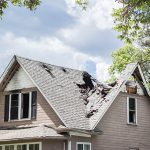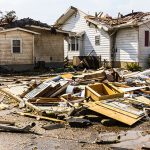How Can I Protect My Home From Tree Damage
Being a homeowner comes with many “what if?” scenarios. Sure, you love the trees in your yard, but what if they break and cause damage to your home? But who doesn’t love a good tree? They add beauty to your yard, provide shade, and are great for curb appeal.
Unfortunately, sometimes Mother Nature has plans for your trees. Plans that, apparently, you weren’t privy to. These plans can end in damage to your home. An entire tree or even branches can uproot in the eye of a particularly nasty storm. They can cause damage to your roof, smash windows, or unhinge shutters. So you may ask yourself: how can I protect my home from tree damage?
First, let’s take a look at what tree damage is and what causes it. Trees, branches, shrubs, and other foliage can become projectiles during the turmoil of a storm, such as a hurricane, tornado, severe lightning and wind storms, and large or copious amounts of hail, to name a few. These unfortunate events can cause substantial structural damage to your home.
You may not be fully aware of what type of damage caused by trees is covered by your insurance company. And insurance companies are often, not always, but often challenging to work with. Having an advocate who knows the ins and outs of the insurance world can help you get your home back in ship shape without the pains of dealing with an insurance company. Especially an insurance company that likes to drag its feet. After all, you need a roof back on your house real quick and in a hurry.
Trees can cause all sorts of problems and damage to your home. Here are some of the most common causes of destruction to your house regarding the botanical world.
- Roof damage caused by falling limbs and branches – when trees are too close to your house, branches may hang over your roof. Although this does provide shade and helps keep your home cool during the summer months, it also puts your roof at risk of severe damage. The best way to avoid this is to maintain the upkeep of trimming your trees.
- Overgrown branches can damage your siding – although damage to the roof caused by fallen limbs may be the most common form of damage from trees, dense trees can be sneaky and wreak havoc on the siding of your home.
- Roots can crack and shift your home’s foundation – this damage can be silent, and it usually takes years to come to light and show its damaging face to your foundation. When roots grow and spread, they pressure the cement slabs that support the structure’s weight.
- Healthy trees = good, sick trees = potential damage to your home – your trees are the best restaurant in town according to insects and pests. Not only do they like to feast on your plants, but they also make their homes in them. They are more attracted to diseased trees, but when a tree dies completely, they will be looking for food (and shelter) elsewhere, such as your home.
- Clogged gutters from falling debris – leaves will fall from trees year-round with bits of bark and twigs. These can build up in your drains and cause blockage, which can cause water damage to your home’s roof, siding, and foundation. Trim your trees at least once a year to reduce the risk of water damage.
There are plenty of ways to prevent damage caused by issues with trees/shrubbery. As a homeowner, you are the first line of defense in protecting your property. Here are a few things you can proactively do to help protect your home.
- Size up large branches – keep a close eye on low-hanging branches, especially those that may hang directly over your roof. You may need to reduce the length of your branches without removing them altogether. Or, you can install cables from branch to branch for support.
- Monitor the health of your trees – the truth is: there are no good or bad species of trees when it comes to fallen branches. However, a tree in poor health may become problematic. Take the time to examine your trees, carefully noting signs of disease, such as mold, critters chewing on the trunk, leaves falling out of season, and flying or crawling insects.
- Prevent problems by planting strategically – you can avoid potential issues down the road if you understand how a tree will mature over time. Trees known for large branches that provide a canopy of shade should be planted at a greater distance from the structure of your home. Also, be aware of how root growth could potentially cause damage to your foundation.
- Prune trees – routine pruning and trimming will prevent weak or loose branches from falling during a storm.
- Regularly check trees for damage – by examining your property’s trees, you may be able to spot a bad, damaged, or diseased tree that may require removal to prevent it from falling on your or your neighbor’s home. When checking your trees, things to be aware of include:
- Trees that significantly lean to one side.
- Trees that are hollow or showing signs of decay.
- Entangled branches.
- Cracks within the trunk of the tree.
- Indications of a weak steam, such as mushrooms growing in the soil.
- Tree limbs that touch power lines.
- Branches that are near, on or hanging over the roof of your house.
If you find yourself a victim of your tree’s leafy wrath, no matter how hard you try to prevent damage, your insurance should be able to help get you back on your feet. Unfortunately, dealing with insurance agencies can often be tricky, and perhaps you are unsure where to start.
Many people find themselves navigating through murky waters when it comes to understanding the ins and outs of filing an insurance claim. Having an expert by your side ensures that you will know what damages are covered and how and when your house will be fixed and fully functioning.
Choosing Douglas Hudson as a travel companion on your journey to understanding your insurance claim will be the smartest choice you may make throughout the whole process. So let us do the heavy lifting and be sure that you get your house back in working order and as quickly as possible. Contact us today to get started.




